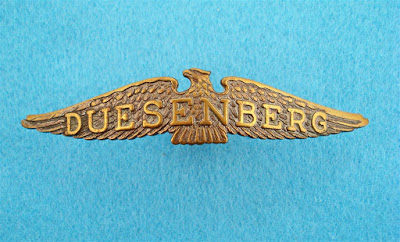Duesenberg Automobile and Motors Corp. (1920-1925)
Duesenberg Motors Co. (1925-1929)
Duesenberg Inc. (1929-1937)
Indianapolis, Indiana
 |
| This is a Duesenberg Model A radiator emblem (1922-1927) mjs Size: 133mm wide 50mm high MM: D L Auld |
The Duesenberg was one of the greatest achievements in America's automotive history but it took a long time to reach its full potential.
Fred S. Duesenberg was a bicycle maker in Iowa who filed for bankruptcy in 1903. He stayed in Iowa where the first car he designed and raced was the Mason. By 1913 Fred Duesenberg and his brother Augie had relocated to St. Paul, Minnesota to organise the Duesenberg Motor Company for the manufacture of auto and marine engines, including the four-cylinder engine used to power Duesenberg competition cars from 1914.
Fred S. Duesenberg was a bicycle maker in Iowa who filed for bankruptcy in 1903. He stayed in Iowa where the first car he designed and raced was the Mason. By 1913 Fred Duesenberg and his brother Augie had relocated to St. Paul, Minnesota to organise the Duesenberg Motor Company for the manufacture of auto and marine engines, including the four-cylinder engine used to power Duesenberg competition cars from 1914.
The Duesenbergs driven in races by Ralph Mulford and Eddie Rickenbacker were hugely successful in contests across America. As a result the Duesenberg name became famous and financial backing was easier to find. Duesenberg Motors Corporation was organised in 1916 and aero engines were produced during the First World War.
After the war the rights to the Duesenberg Four auto engine was sold to Rochester Motors Company and Fred Duesenberg started to develop a new eight-cylinder racing car engine. He had plans for a passenger car and, in 1920, the Duesenberg Automobile and Motors Corporation was established.
The prototype Model A Duesenberg was introduced at the Commodore Hotel in November 1920 but by then Fred Duesenberg had already decided to change and improve the engine design. The new Model A created a sensation but it was the 1922 model year before the car was available with the improved overhead camshaft engine. At the same time the Duesenberg continued to enjoy huge success in racing competitions.
After the war the rights to the Duesenberg Four auto engine was sold to Rochester Motors Company and Fred Duesenberg started to develop a new eight-cylinder racing car engine. He had plans for a passenger car and, in 1920, the Duesenberg Automobile and Motors Corporation was established.
The prototype Model A Duesenberg was introduced at the Commodore Hotel in November 1920 but by then Fred Duesenberg had already decided to change and improve the engine design. The new Model A created a sensation but it was the 1922 model year before the car was available with the improved overhead camshaft engine. At the same time the Duesenberg continued to enjoy huge success in racing competitions.
In 1925 the company was reorganised as the Duesenberg Motors Company but the company was not profitable. In 1926 the Duesenberg company was acquired by Errett Loban Cord, who gave Fred Duesenberg the task of building a supercar that would be as good as or better than the world's most magnificent automobiles. The Model X Duesenberg was produced in 1927 but only 13 cars were built. Then, on December 1, 1928 at the New York Automobile Salon, the Model J Duesenberg was unveiled. It achieved all that Cord had requested.
Before Fred Duesenberg died in 1932 he had developed the design of a supercharger that was improved by his brother and which was used in tests to boost the power of the Model J to about 400 hp with speeds of up to 150 mph. But, Duesenberg suffered during the Depression and was finished by 1937 following Cord's sale of his automotive corporation. In total only about 480 Model J cars were built.
Emblems
Duesenberg emblems are much sought after by collectors.
Duesenberg emblems are much sought after by collectors.
The Duesenberg Model A radiator emblem shown above at the top of this page is rare and was used on passenger cars and also on Duesenberg race cars, see example below:
 |
| This is the radiator emblem on the Duesenberg that won the 1922 Indy 500 (1921) isam |
Beware, there are reproduction Duesenberg emblems like the radiator emblem shown above but with no maker's mark, including a Greenland style reproduction with two internally threaded studs and no maker's mark.
The Duesenberg Model J carried a smaller more discrete emblem on the nose of the radiator, see example below. This emblem is very rare, probably because so many of the Duesenberg Model J automobiles have survived.
 |
| This is a Duesenberg Model J radiator emblem (1929-1937) mjs Size: 93mm wide 18mm high MM: D L Auld |
The Model J continued to carry the larger Duesenberg emblem but on a backing plate attached to the firewall behind the engine, see example below. This emblem is also very rare.
 |
| This is a Duesenberg Model J firewall emblem (1929-1937) mjs Size: 170mm wide 65mm high overall MM: D L Auld |
The Duesenberg firewall emblem shown below is from a Duesenberg Model X and is extremely rare.
 |
| This is a Duesenberg Model X firewall emblem (1927) mjs Size: 170mm wide 65mm high MM: D L Auld |
The emblem shown below is a Duesenberg Model A hub emblem.

No comments:
Post a Comment